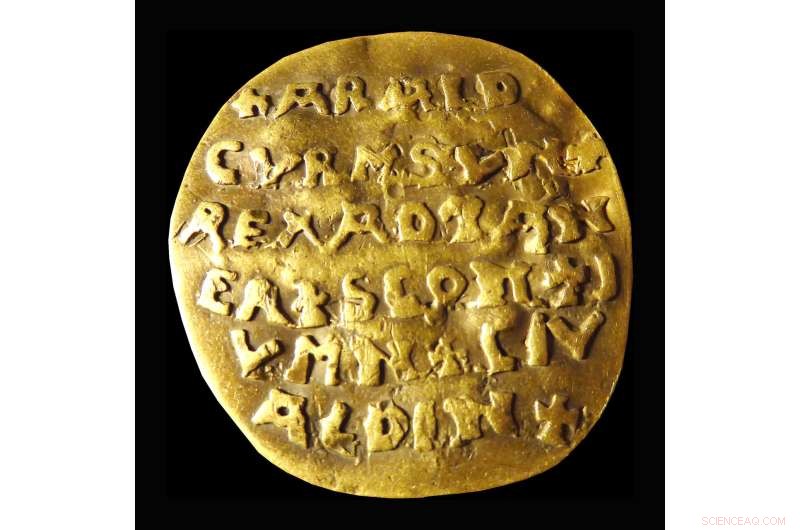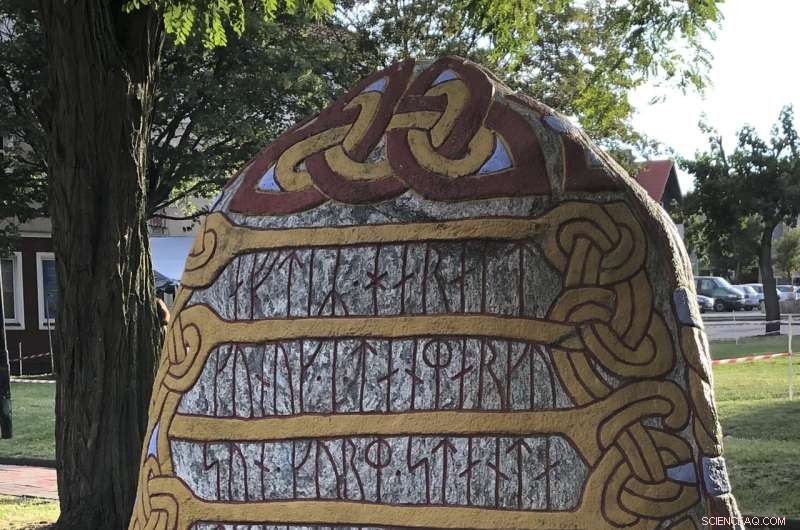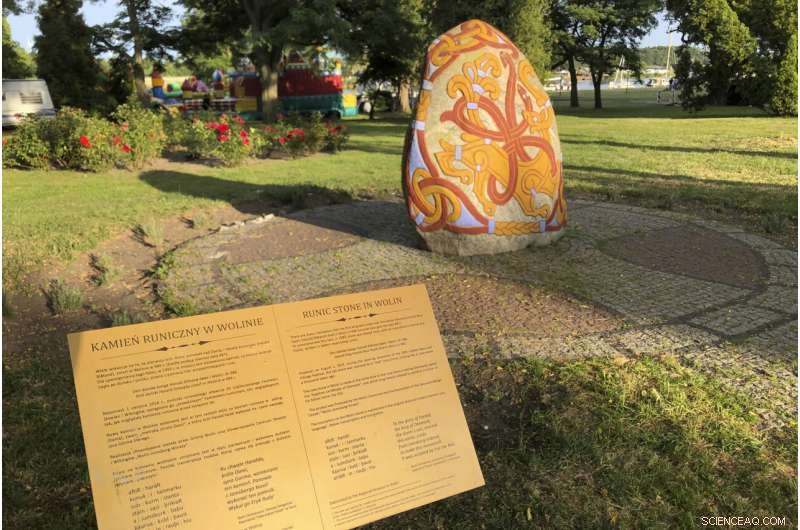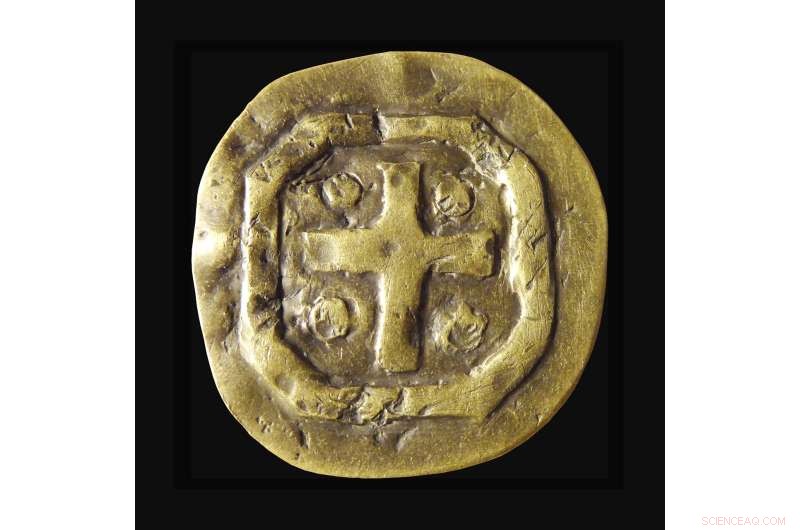
Il disco d'oro di Curmsun del X secolo con il nome del re danese Harald "Bluetooth" Gormsson (Curmsun in latino), proveniente da una tomba nella chiesa cattolica romana di Wiejkowo, in Polonia, fotografato a Malmo, in Svezia, nel 2015. Il Bluetooth la tecnologia di collegamento wireless prende il nome dal re. Più di 1.000 anni dopo la sua morte in quella che oggi è la Polonia, un re danese il cui soprannome è noto al mondo attraverso la tecnologia Bluetooth è al centro di una disputa archeologica. Credito:Sven Rosborn tramite AP
Più di 1.000 anni dopo la sua morte in quella che oggi è la Polonia, un re europeo il cui soprannome sopravvive grazie alla tecnologia wireless è al centro di una disputa archeologica.
Le cronache del Medioevo dicono che il re Harald "Bluetooth" Gormsson di Danimarca acquisì il suo soprannome per gentile concessione di un dente, probabilmente morto, che sembrava bluastro. Una cronaca dell'epoca dice anche che il re vichingo fu sepolto a Roskilde, in Danimarca, alla fine del X secolo.
Ma un archeologo svedese e un ricercatore polacco hanno recentemente affermato in pubblicazioni separate di aver individuato il suo luogo di sepoltura più probabile nel villaggio di Wiejkowo, in un'area della Polonia nordoccidentale che aveva legami con i Vichinghi ai tempi di Harald.
Marek Kryda, autore del libro "Polonia vichinga", ha detto all'Associated Press che un "tumulo pagano" che sostiene di aver situato sotto la chiesa cattolica romana di Wiejkowo del XIX secolo probabilmente custodisce le spoglie del re. Kryda ha affermato che le immagini satellitari geologiche disponibili su un portale del governo polacco hanno rivelato una forma rotonda che sembrava un tumulo vichingo.
Ma l'archeologo svedese Sven Rosborn, dice che Kryda si sbaglia perché Harald, che si convertì dal paganesimo al cristianesimo e fondò chiese nella zona, deve aver ricevuto una tomba appropriata da qualche parte nel cimitero. La Chiesa dell'Immacolata della Beata Vergine Maria di Wiejkowo si trova in cima a una piccola collinetta rotonda.

Una vista di una pietra del 2014 con iscrizione runica in memoria del re danese Harald "Bluetooth" Gormsson del X secolo, a Wolin, Polonia, sabato 30 luglio 2022. Più di 1.000 anni dopo la sua morte in quella che oggi è la Polonia, un re danese il cui soprannome è noto al mondo attraverso la tecnologia Bluetooth è al centro di una disputa archeologica. Un ricercatore polacco e un archeologo svedese affermano di aver individuato il probabile luogo di sepoltura del re Harald Bluetooth Gormsson in un piccolo villaggio della Polonia nord-occidentale, un'area che un tempo aveva legami con i Vichinghi. Credito:AP Photo Monika Scislowska
Gli storici del Museo Nazionale Danese di Copenaghen affermano di conoscere il "suggerimento" che Wiejkowo sia il luogo di sepoltura di Harald.
Rosborn ha dettagliato la sua ricerca nel libro del 2021 "Il tesoro d'oro del re vichingo" e Kryda ha contestato alcune delle scoperte dello svedese nel suo stesso libro pubblicato quest'anno.
Harald, who died in 985, probably in Jomsborg—which is believed to be the Polish town of Wolin now—was one of the last Viking kings to rule over what is now Denmark, northern Germany, and parts of Sweden and Norway. He spread Christianity in his kingdom.
Swedish telecommunications company Ericsson named its Bluetooth wireless link technology after the king, reflecting how he united much of Scandinavia during his lifetime. The logo for the technology is designed from the Scandinavian runic letters for the king's initials, HB.

A view of a 2014 stone with runic inscription in memory of Danish 10th century King Harald “Bluetooth” Gormsson, in Wolin, Poland, Saturday, July 30,2022. More than 1,000 years after his death in what is now Poland, a Danish king whose nickname is known to the world through the Bluetooth technology is at the center of an archeological dispute. A Polish researcher and a Swedish archeologist claim that they have pinpointed the probable burial site for King Harald Bluetooth Gormsson in a small village in northwestern Poland, an area that once had ties with the Vikings. Credit:AP Photo Monika Scislowska
Rosborn, the former director of Sweden's Malmo City Museum, was spurred on his quest in 2014 when an 11-year-old girl sought his opinion about a small, soiled coin-like object with old-looking text that had been in her family's possession for decades.
Experts have determined that the cast gold disk that sparked Maja Sielski's curiosity dated from the 10th century. The Latin inscription on what is now known as the "Curmsun disk" says:"Harald Gormsson (Curmsun in Latin) king of Danes, Scania, Jomsborg, town Aldinburg."
Sielski's family, who moved to Sweden from Poland in 1986, said the disk came from a trove found in 1841 in a tomb underneath the Wiejkowo church, which replaced a medieval chapel.
The Sielski family came into the possession of the disk, along with the Wiejkowo parish archives that contained medieval parchment chronicles in Latin, in 1945 as the former German area was becoming part of Poland as a result of World War II.

The Roman Catholic church where it is believed that Danish King Harald Gormsson was buried, in Wiejkowo, Poland, Saturday, July 30, 2022. More than 1,000 years after his death in what is now Poland, a Danish king whose nickname is known to the world through the Bluetooth technology is at the center of an archeological dispute. A Polish researcher and a Swedish archeologist claim that they have pinpointed the probable burial site for King Harald Bluetooth Gormsson in a small village in northwestern Poland, an area that once had ties with the Vikings. Credit:AP Photo Monika Scislowska

A view inside the Roman Catholic church where it is believed that Danish King Harald Gormsson was buried, in Wiejkowo, Poland, Saturday, July 30, 2022. More than 1,000 years after his death in what is now Poland, a Danish king whose nickname is known to the world through the Bluetooth technology is at the center of an archeological dispute. A Polish researcher and a Swedish archeologist claim that they have pinpointed the probable burial site for King Harald Bluetooth Gormsson in a small village in northwestern Poland, an area that once had ties with the Vikings. Credit:AP Photo Monika Scislowska

The 10th century golden Curmsun disc with the name of Danish King Harald “Bluetooth“ Gormsson (Curmsun in Latin) on it, coming from a tomb at the Roman Catholic church in Wiejkowo, Poland, photographed in Malmo, Sweden, in 2015. The Bluetooth wireless link technology is named after the king. More than 1,000 years after his death in what is now Poland, a Danish king whose nickname is known to the world through the Bluetooth technology is at the center of an archeological dispute. Credit:Sven Rosborn via AP
A family member who knew Latin understood the value of the chronicles—which dated as far back as the 10th century—and translated some of them into Polish. They mention Harald, another fact linking the Wiejkowo church to him.
The nearby Baltic Sea island and town of Wolin cultivates the region's Viking history:it has a runic stone in honor of Harald Bluetooth and holds annual festivals of Slavs and Vikings.
Kryda says the Curmsun disk is "phenomenal" with its meaningful inscription and insists that it would be worth it to examine Wiejkowo as Harald's burial place, but there are no current plans for any excavations. + Esplora ulteriormente
© 2022 Associated Press. Tutti i diritti riservati. Questo materiale non può essere pubblicato, trasmesso, riscritto o ridistribuito senza autorizzazione.